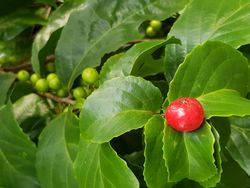Flacourtia indica
Flacourtia indica (Burm. f.) Merr.
| Ordre | Malpighiales |
|---|---|
| Famille | Salicaceae |
| Genre | Flacourtia |
2n =
Origine : aire d'origine
sauvage ou cultivé
| Français | ' |
|---|---|
| Anglais | ' |
- fruit comestible
- médicinal (Ayurveda)
- planté en haies et comme brise-vent
- fourrage : rameaux feuillés
Description
Noms populaires
| français | grosse prune-café (Guadeloupe) ; prune de Madagascar (Martinique) (Rollet) |
| anglais | Madagascar plum, governor’s plum (Rollet) |
| Philippines | bitolgol (tagalog), bolong (mangyan), palutan (ibanag) (PROSEA) |
| Indonésie | duri rukem (indonésien), saradan (sundanais), baga (Java) (PROSEA) |
| Malaysia | kerkup kecil (PROSEA) |
| Thaïlande | takhop-pa (centre), makwen-pa, makwen-nok (nord) (PROSEA) |
| Vietnam | hông qûân, muôn quân, ân do (PROSEA) |
| Cambodge | krâk hôp nhii (PROSEA) |
Classification
Flacourtia indica (Burm. f.) Merr. (1917)
basionyme :
- Gmelina indica Burm. f. (1768)
synonyme :
- Flacourtia ramontchi LʼHér. (1786)
Cultivars
Histoire
Usages
Nearly everywhere cultivated in the tropics of the Old World and less often of the New World. The acidic to rather sweet fruits are eaten fresh (if completely ripe) or used for preserves, jams, jellies and pies. Incompletely ripe fruits are often astringent. Important Ayurvedic drug. Infusions of bark, leaves and root are medicinally used against fever, diarrhea, inflammations, etc. In Puerto Rico and other places planted as tall hedge and windbreak. In India the branches are lopped for fodder. Cultivars are sometimes grafted on F. inermis or F. rukam rootstocks. Small but constant morphological, karyological, phytochemical etc. differences support to split off F. sepiaria as separate species. Because many data on cultivation do not distinguish between both taxa, F. indica is used here in the broad sense.
Références
- Bekele-Tesemma, Azene, 2007. Useful trees and shrubs for Ethiopia. Identification, propagation and management for 17 agroclimatic zones. Nairobi, ICRAF - RELMA. 550 p. (Technical Manual 6). Voir l'article
- Rollet, Bernard et coll., 2010. Arbres des Petites Antilles. Tome 1 : Introduction à la dendrologie. 276 p. Tome 2 : Description des espèces. 866 p. + 46 pl. coul. + CD de photos sur l'anatomie du bois. Basse-Terre, ONF. Voir sur Pl@ntUse.




